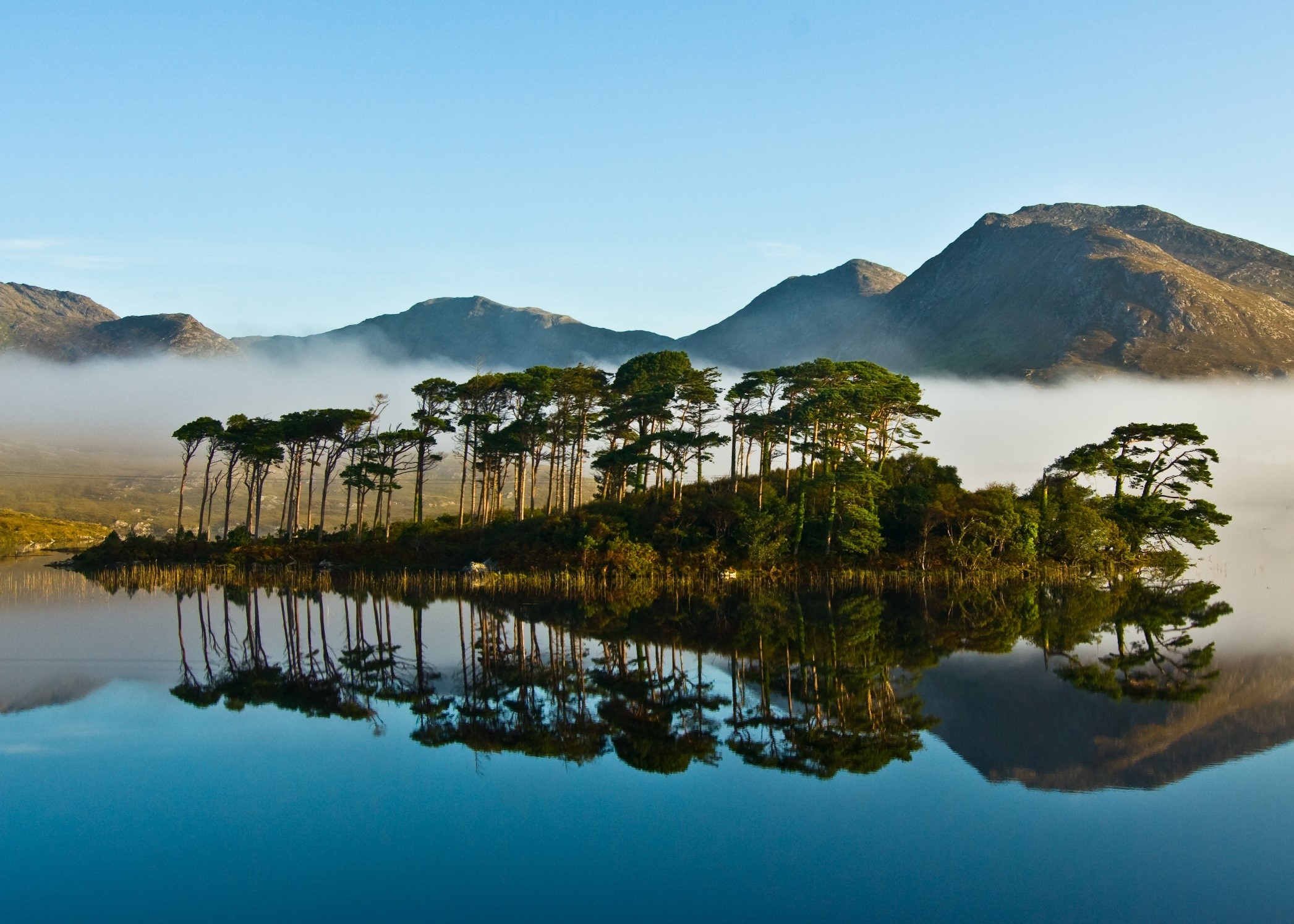
There really is something in Ireland for everyone!
From Walking to Whiskey Tasting, History to Heritage, Music to Mountains, Surfing to Storytelling and of course Guinness to Golf, Ireland has it all!
But what are the Top 10 “Must See” Tourist attractions in Ireland? We’ve listed our favourite 10 below (in alphabetical order), and it was an extremely difficult task to choose these!
- Aran Islands
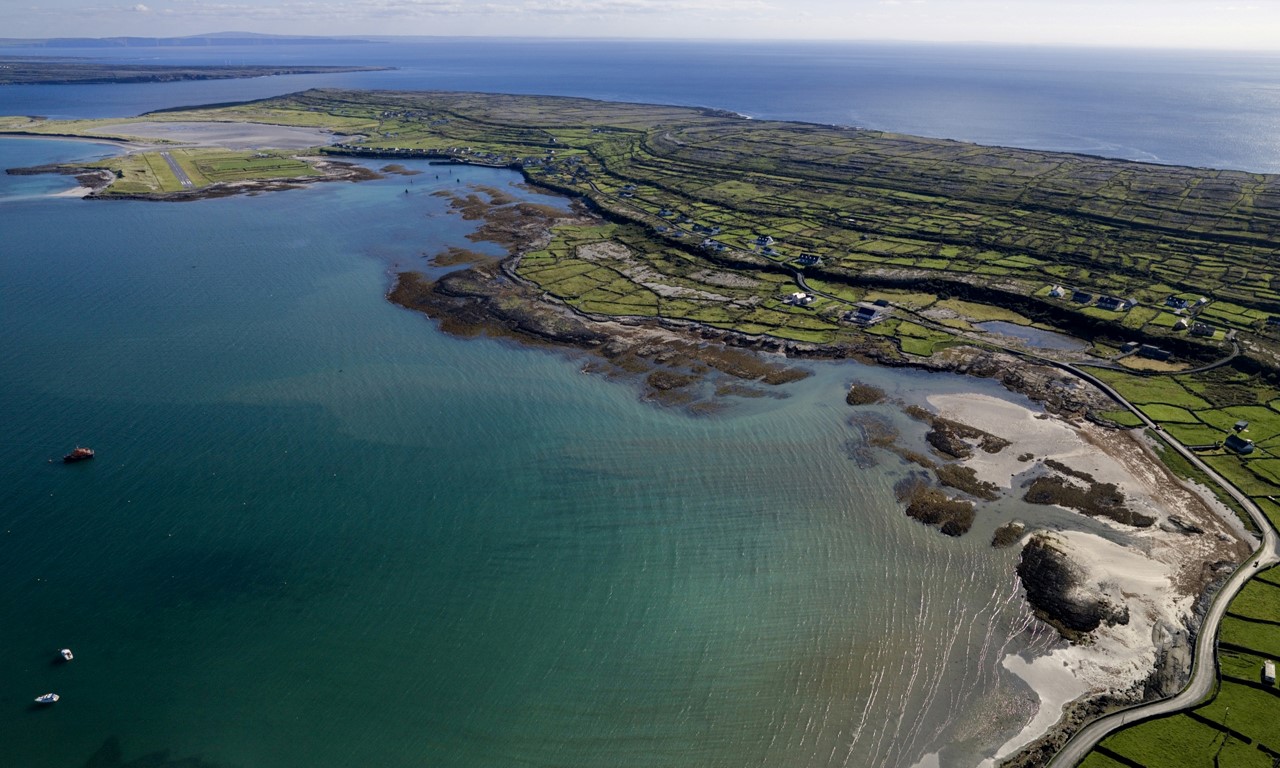 In Galway Bay lie three rocky limestone outcrops that make up the Aran Islands. They are a bastion of traditional language, culture and music, unique in their geology and archaeology and unrivalled in their potent sense of history.Each of the three islands, Inishmore (Árainn), Inishmaan (Inis Meáin) and Inisheer (Inis Oírr) have their own distinct atmosphere and character, but the dramatic landscapes and endless sea form a backdrop to a labyrinth of meandering stone walls and tiny, tightly packed fields. In between, a network of narrow winding roads and grassy lanes sweep from pristine beaches and craggy shores to the dizzying cliffs that mark the edge of Europe.The islands have lured legions of writers, artists and visitors over the centuries, their enigmatic ancient monuments, early Christian remains, holy wells and historic lighthouses adding to their sense of timelessness and mystery.The pace of life is slow here and a profound sense of peace accompanies any walk or cycle down the narrow grassy lanes. This serenity makes the islands a precious sanctuary from the rush of modern life and their isolation guarantees their place as a stronghold of traditional culture. The nightly music sessions, lively dances, traditional crafts, seagoing currachs and wonderfully warm and welcoming spirit are inimitable parts of the Aran Islands.
In Galway Bay lie three rocky limestone outcrops that make up the Aran Islands. They are a bastion of traditional language, culture and music, unique in their geology and archaeology and unrivalled in their potent sense of history.Each of the three islands, Inishmore (Árainn), Inishmaan (Inis Meáin) and Inisheer (Inis Oírr) have their own distinct atmosphere and character, but the dramatic landscapes and endless sea form a backdrop to a labyrinth of meandering stone walls and tiny, tightly packed fields. In between, a network of narrow winding roads and grassy lanes sweep from pristine beaches and craggy shores to the dizzying cliffs that mark the edge of Europe.The islands have lured legions of writers, artists and visitors over the centuries, their enigmatic ancient monuments, early Christian remains, holy wells and historic lighthouses adding to their sense of timelessness and mystery.The pace of life is slow here and a profound sense of peace accompanies any walk or cycle down the narrow grassy lanes. This serenity makes the islands a precious sanctuary from the rush of modern life and their isolation guarantees their place as a stronghold of traditional culture. The nightly music sessions, lively dances, traditional crafts, seagoing currachs and wonderfully warm and welcoming spirit are inimitable parts of the Aran Islands. - Blarney Castle
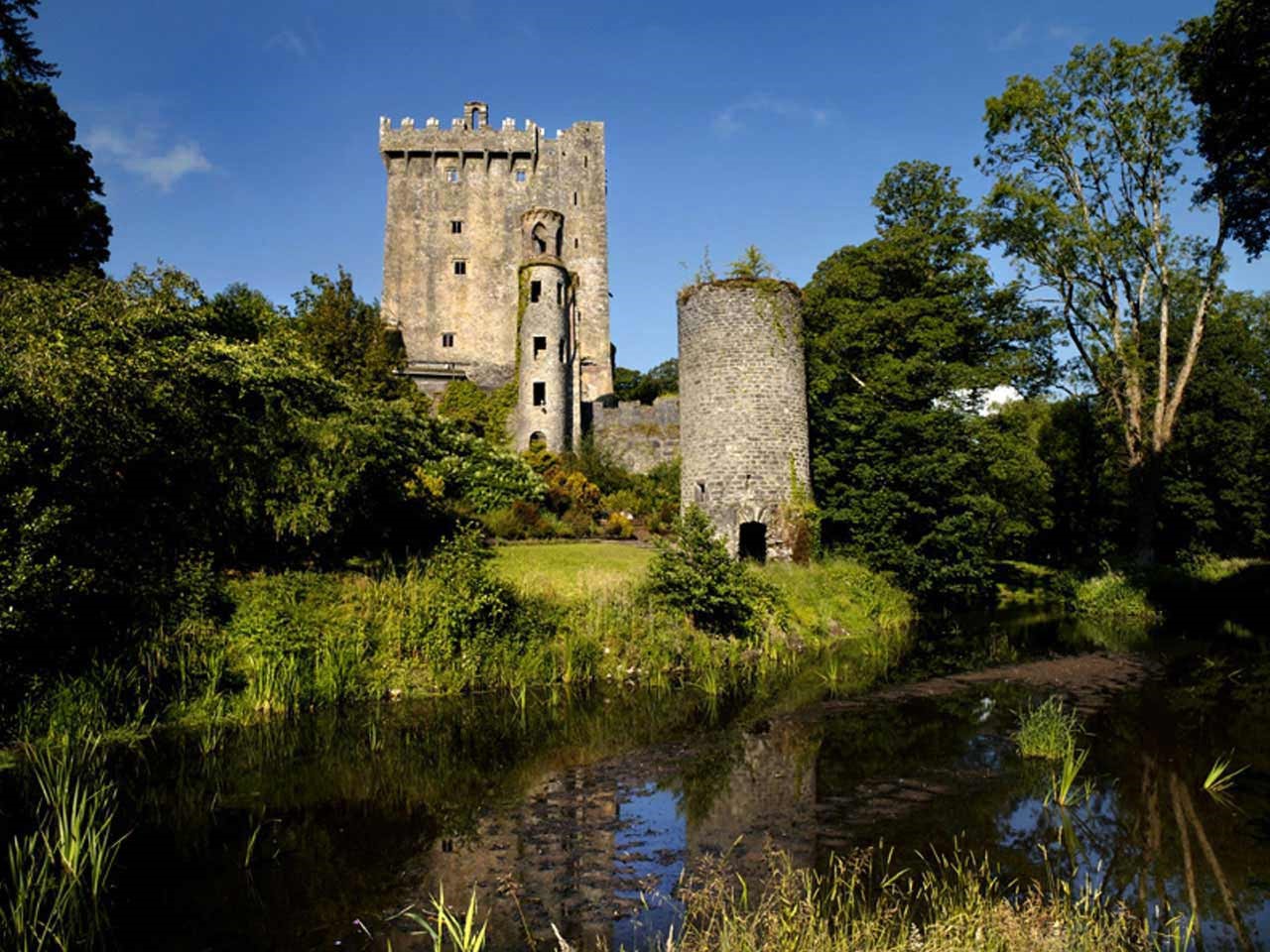 The historic Blarney Castle near Cork City is perhaps most famous for the Blarney Stone but it’s also a great destination for the whole family. According to legend, the stone has the power to give anyone who kisses it the ‘gift of the gab’ (or the ability to be a smooth talker), so for those who dare, a climb to the battlements to reach the famous stone could be well worth it.For a more relaxing experience, take a stroll through the Blarney Castle Gardens and Rock Close—an attractive destination in their own right. There are a range of themed gardens built into the estate, like Fern Garden, located deep in the woods and designed to feel like a tropical jungle. Poison Garden, beside the battlements, is home to a fascinating collection of deadly and dangerous plants from around the world, like the caged specimens of deadly nightshade, wolfsbane and poison ivy.Get in touch with your Celtic past at the Rock Close, a mystical place where majestic yew and oak trees grow around an ancient druidic settlement. Follow the trail through giant gunnera leaves and bamboo and you’ll find a giant dolmen stone, a set of ‘wishing steps’ and a witch’s kitchen. The water garden and waterfalls create the perfect backdrop to a magical experience for visitors.In springtime, the castle grounds are filled with thousands of flower bulbs and the ‘Belgian Beds’ are covered with hybrid azaleas in full flower. In autumn, the landscaped arboretum glows as the leaves of the trees turn red, amber and gold.
The historic Blarney Castle near Cork City is perhaps most famous for the Blarney Stone but it’s also a great destination for the whole family. According to legend, the stone has the power to give anyone who kisses it the ‘gift of the gab’ (or the ability to be a smooth talker), so for those who dare, a climb to the battlements to reach the famous stone could be well worth it.For a more relaxing experience, take a stroll through the Blarney Castle Gardens and Rock Close—an attractive destination in their own right. There are a range of themed gardens built into the estate, like Fern Garden, located deep in the woods and designed to feel like a tropical jungle. Poison Garden, beside the battlements, is home to a fascinating collection of deadly and dangerous plants from around the world, like the caged specimens of deadly nightshade, wolfsbane and poison ivy.Get in touch with your Celtic past at the Rock Close, a mystical place where majestic yew and oak trees grow around an ancient druidic settlement. Follow the trail through giant gunnera leaves and bamboo and you’ll find a giant dolmen stone, a set of ‘wishing steps’ and a witch’s kitchen. The water garden and waterfalls create the perfect backdrop to a magical experience for visitors.In springtime, the castle grounds are filled with thousands of flower bulbs and the ‘Belgian Beds’ are covered with hybrid azaleas in full flower. In autumn, the landscaped arboretum glows as the leaves of the trees turn red, amber and gold. - Bru na Boinne
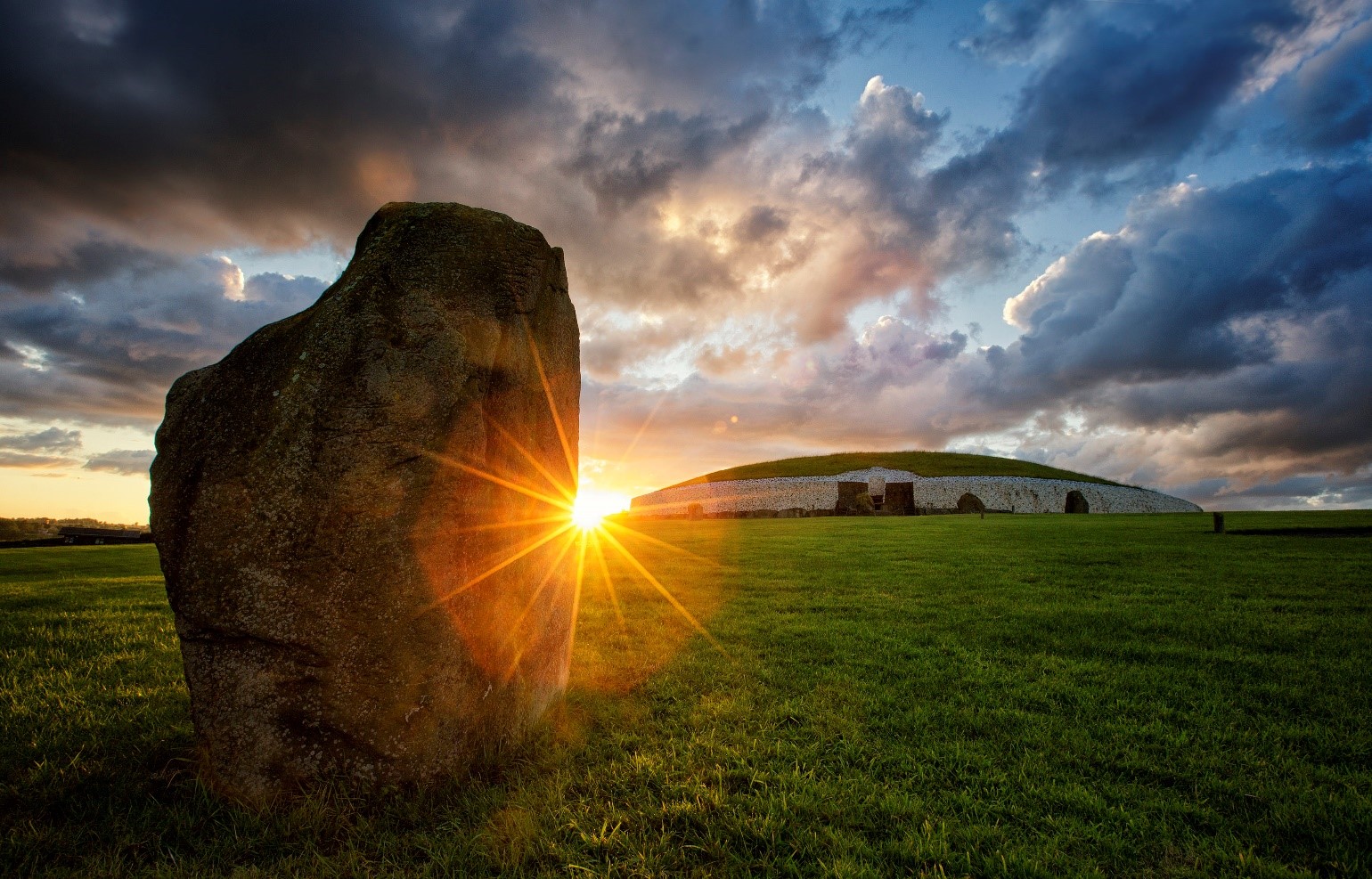 The Brú na Bóinne Visitor Centre in Donore, County Meath, is an information hub for the thousands of visitors eager to explore Ireland’s mysterious Neolithic monuments, Newgrange, Knowth and Dowth. An extensive exhibition includes a full scale replica of the chamber at Newgrange (a World Heritage site), as well as a model of one of the smaller tombs at Knowth.Located on the south side of the River Boyne, the Brú na Bóinne Visitor Centre is the only access point to Newgrange and Knowth, which lie north of the river. All tours of Newgrange start at the centre, before visitors cross the river via a footbridge and are brought by shuttle bus to the monuments. Because space inside the monuments is limited, places are restricted to around 700 per day at high season, meaning the summer months are particularly busy.
The Brú na Bóinne Visitor Centre in Donore, County Meath, is an information hub for the thousands of visitors eager to explore Ireland’s mysterious Neolithic monuments, Newgrange, Knowth and Dowth. An extensive exhibition includes a full scale replica of the chamber at Newgrange (a World Heritage site), as well as a model of one of the smaller tombs at Knowth.Located on the south side of the River Boyne, the Brú na Bóinne Visitor Centre is the only access point to Newgrange and Knowth, which lie north of the river. All tours of Newgrange start at the centre, before visitors cross the river via a footbridge and are brought by shuttle bus to the monuments. Because space inside the monuments is limited, places are restricted to around 700 per day at high season, meaning the summer months are particularly busy.
A seasonal bus service runs from the town of Drogheda to the Brú na Bóinne Visitor Centre through Donore village. Open all year round, the centre has longer opening hours in summer. As well as a full scale replica of the Newgrange Chamber, the Brú na Bóinne Visitor Centre features a large interactive exhibition on the Brú na Bóinne area, an audio-visual presentation, the Brú na Bóinne tourist office, gift shop and tea rooms. A large car park and a picnic area are available outside.
The mysteriously beautiful Newgrange prehistoric monument offers glorious views of the Boyne Valley. Among the finest surviving examples of this type of monument in Europe, Newgrange attracts thousands of international visitors every year. Visit the Brú na Bóinne Visitor Centre to start your own tour of this treasured national landmark.
- Cliffs of Moher
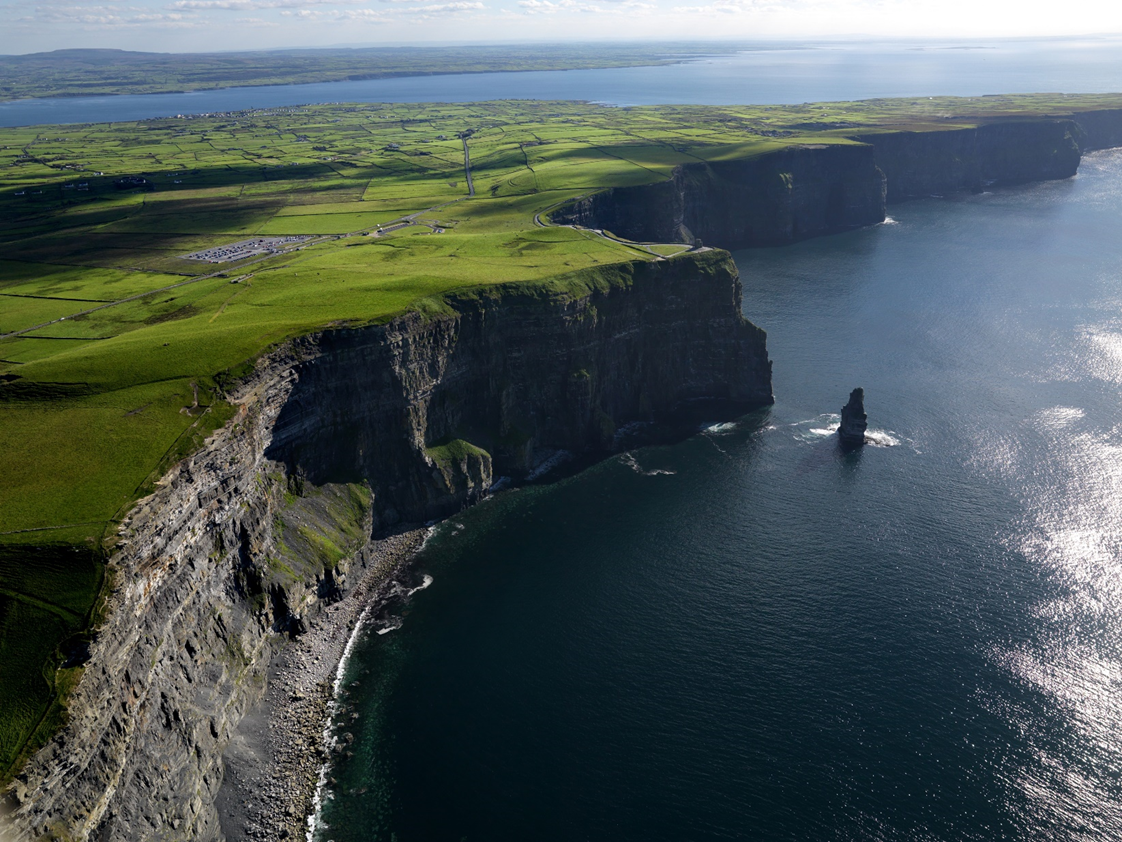 The Cliffs of Moher are Ireland’s most visited natural attraction. They stretch for 8km (5miles), as the crow flies, along the Atlantic coast of County Clare in the west of Ireland and reach 214m (702feet) at their highest point at Knockardakin just north of O’Brien’s Tower.At the southern end of the Cliffs of Moher stands Hags Head a natural rocky promontory that resembles a seated woman when viewed from the north. In the ancient Gaelic language, the word Mothar means “ruined fort” and a 1st century BC fort stood where Moher tower now stands. Therefore the Cliffs of Moher means the cliffs of the ruined fort and although there is no trace remaining of this two thousand year old fort it has given name to the cliffs which are visited annually by almost one million visitors.
The Cliffs of Moher are Ireland’s most visited natural attraction. They stretch for 8km (5miles), as the crow flies, along the Atlantic coast of County Clare in the west of Ireland and reach 214m (702feet) at their highest point at Knockardakin just north of O’Brien’s Tower.At the southern end of the Cliffs of Moher stands Hags Head a natural rocky promontory that resembles a seated woman when viewed from the north. In the ancient Gaelic language, the word Mothar means “ruined fort” and a 1st century BC fort stood where Moher tower now stands. Therefore the Cliffs of Moher means the cliffs of the ruined fort and although there is no trace remaining of this two thousand year old fort it has given name to the cliffs which are visited annually by almost one million visitors.
The Cliffs of Moher Visitor Experience is located almost midway along these spectacular cliffs and is home to; an environmentally friendly visitor centre set into the hillside, O’Brien’s Tower – a 19th century viewing tower, and 800metres of protected cliff side pathways, viewing areas and steps.
- Giants Causeway
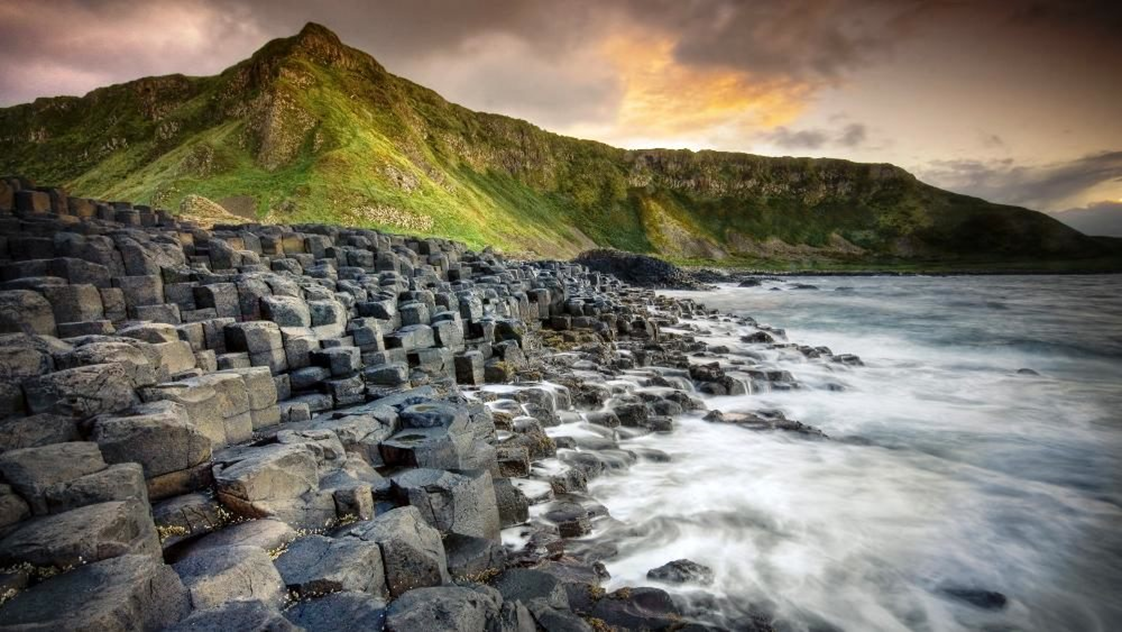 Flanked by the wild North Atlantic Ocean and a landscape of dramatic cliffs, for centuries the Giant’s Causeway has inspired artists, stirred scientific debate and captured the imagination of all who see it.Now it’s time to experience the Giant’s Causeway for yourself! Visit the world-famous basalt columns with one of the knowledgeable tour guides, or pick up an audio guide and go at your own pace. Climb the Shepherd’s Steps and hike along the cliff-top trail to get a bird’s eye view of the beautiful causeway coast.Unlock the mystery and stories of the landscape in the exhibition area of the award-winning visitor centre, which also boasts a café serving a seasonal menu, and retail zone where you can pick up locally sourced souvenirs and handicrafts. For centuries countless visitors have marvelled at the majesty and mystery of the Giants Causeway. At the heart of one of Europe’s most magnificent coastlines its unique rock formations have, for millions of years, stood as a natural rampart against the unbridled ferocity of Atlantic storms. The rugged symmetry of the columns never fails to intrigue and inspire our visitors. To stroll on the Giants Causeway is to voyage back in time.
Flanked by the wild North Atlantic Ocean and a landscape of dramatic cliffs, for centuries the Giant’s Causeway has inspired artists, stirred scientific debate and captured the imagination of all who see it.Now it’s time to experience the Giant’s Causeway for yourself! Visit the world-famous basalt columns with one of the knowledgeable tour guides, or pick up an audio guide and go at your own pace. Climb the Shepherd’s Steps and hike along the cliff-top trail to get a bird’s eye view of the beautiful causeway coast.Unlock the mystery and stories of the landscape in the exhibition area of the award-winning visitor centre, which also boasts a café serving a seasonal menu, and retail zone where you can pick up locally sourced souvenirs and handicrafts. For centuries countless visitors have marvelled at the majesty and mystery of the Giants Causeway. At the heart of one of Europe’s most magnificent coastlines its unique rock formations have, for millions of years, stood as a natural rampart against the unbridled ferocity of Atlantic storms. The rugged symmetry of the columns never fails to intrigue and inspire our visitors. To stroll on the Giants Causeway is to voyage back in time.
Your imagination will travel along stepping stones that lead to either the creative turbulence of a bygone volcanic age or into the mists and legends of the past.
In 1986 the Giants Causeway Visitors centre opened, coinciding with the World Heritage Conventions addition of the Causeway to its coveted list of sites, which are of exceptional interest and universal value.
The National Trust are the custodians of the Causeway and provide the National Trust Shop and Tea Rooms. The centre caters for the interest and enjoyment of the half a million tourists that visit the Giants Causeway each year. The management, the staff and facilities are at your disposal during a visit that we hope will be the first of many.
This is an iconic tourist attraction.
- Glendalough
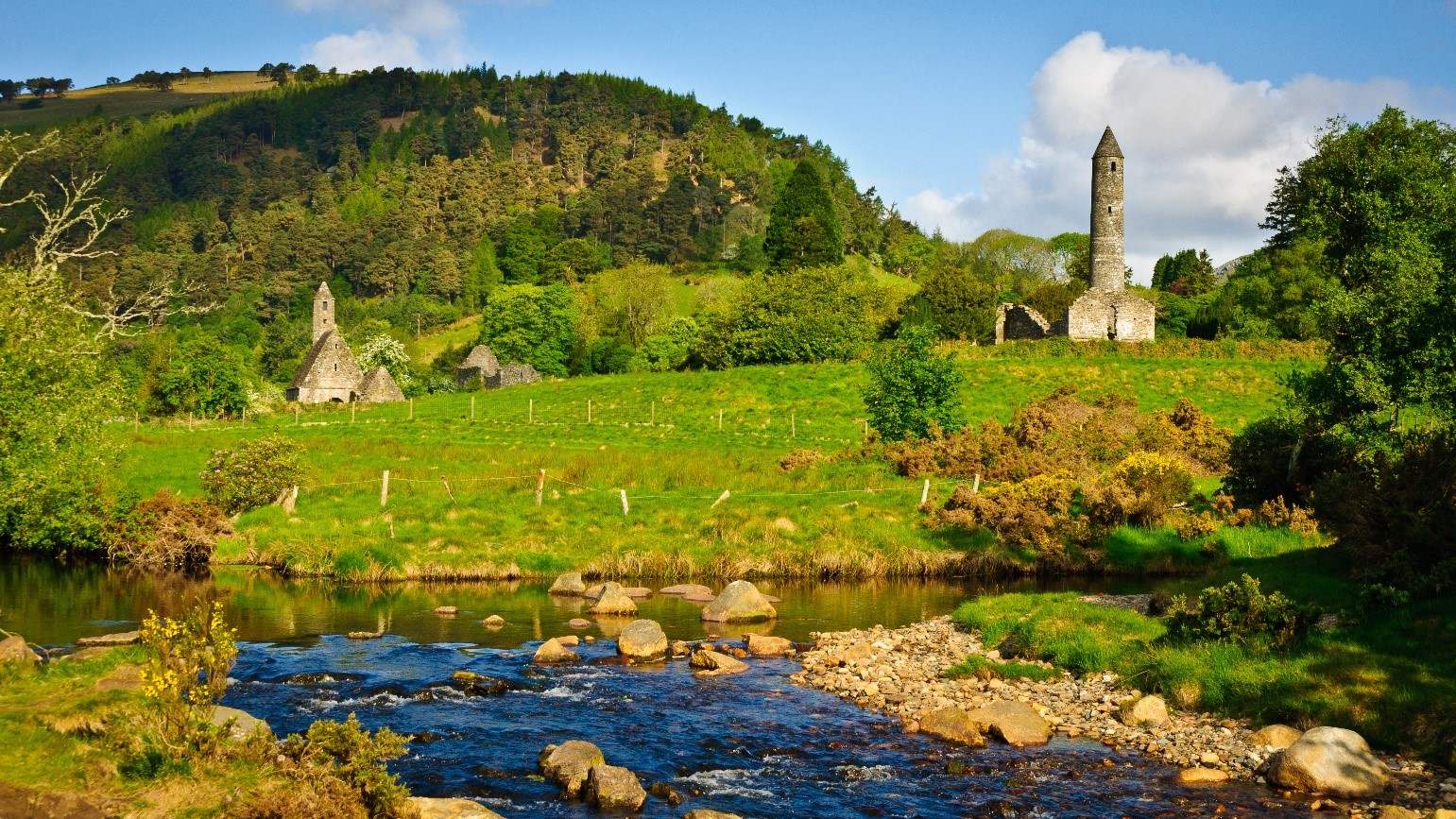 Glendalough Visitor Centre is dedicated to showcasing the Glendalough monastic site, one of Ireland’s most famous tourist attractions. Positioned in a glaciated valley with two lakes, the Glendalough monastic site is a fascinating early Christian settlement in a spectacular natural location, founded by Saint Kevin in the 6th century.The extensive ruins of Glendalough include several early churches, and an impressive 30-metre high round tower. The valley stretches for approximately 3km and contains several areas of great historical interest and beauty. The Upper Lake area was the original site of the monastic settlement and features Reefert Church, Temple-na-Skellig, Saint Kevin’s Cell, Saint Kevin’s Bed, the Caher and various high crosses.
Glendalough Visitor Centre is dedicated to showcasing the Glendalough monastic site, one of Ireland’s most famous tourist attractions. Positioned in a glaciated valley with two lakes, the Glendalough monastic site is a fascinating early Christian settlement in a spectacular natural location, founded by Saint Kevin in the 6th century.The extensive ruins of Glendalough include several early churches, and an impressive 30-metre high round tower. The valley stretches for approximately 3km and contains several areas of great historical interest and beauty. The Upper Lake area was the original site of the monastic settlement and features Reefert Church, Temple-na-Skellig, Saint Kevin’s Cell, Saint Kevin’s Bed, the Caher and various high crosses.
Glendalough Visitor Centre offers an exhibition, audio-visual shows, guided tours and is fully accessible for visitors with disabilities; access to the monastic site itself however is very limited.
This beautiful area is ideal as a base for hikes and is suitable for all levels, ranging from a short stroll around the ruins to demanding mountain walks through the valley and around the lakes.
- Guinness Storehouse
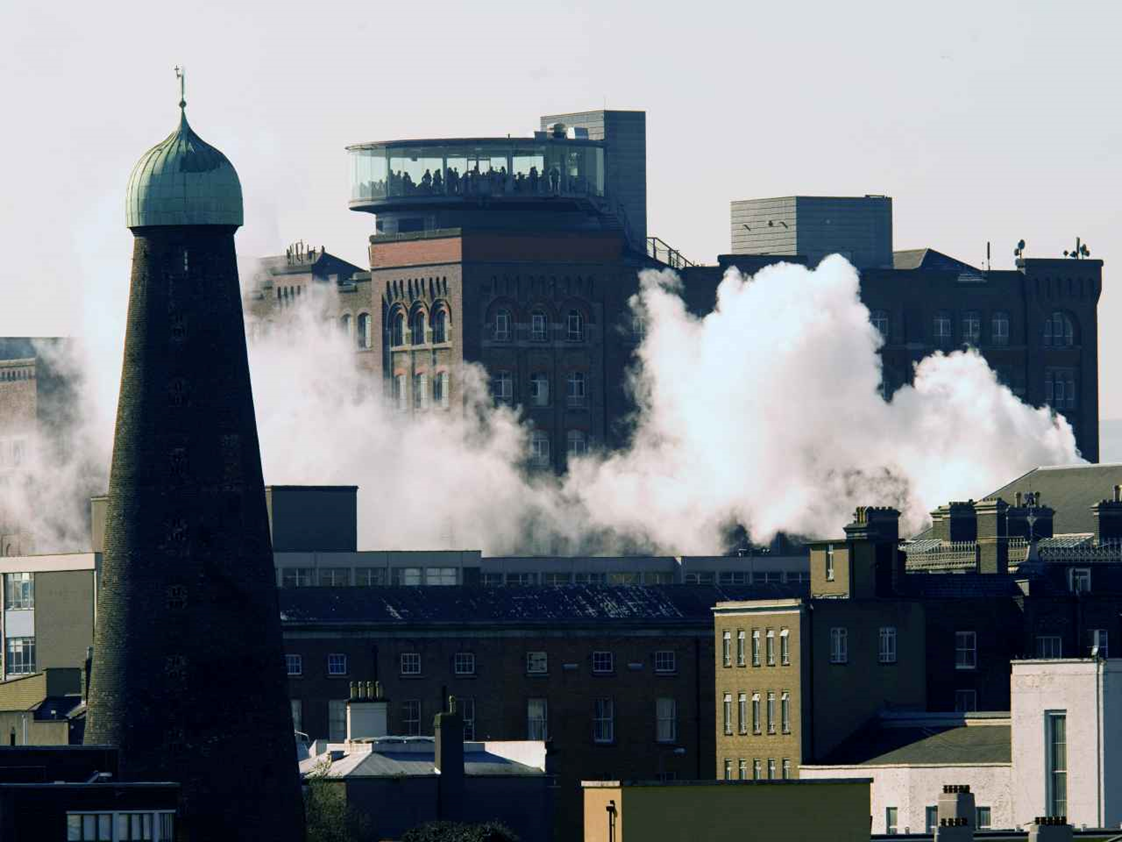 Guinness is synonymous with Ireland and no visit to Dublin is complete without a trip to the Guinness Storehouse – the Home of Guinness.Located in the heart of the legendary St. James’s Gate Brewery in Dublin, this production site has been home to the Guinness Brewery since 1759, when Arthur Guinness signed a lease for 9,000 years. The Guinness Storehouse building dates back to 1904 and is built in the style of the Chicago School of Architecture. It was once the fermentation plant of the brewery and is now a seven-storey visitor experience dedicated to the history of the making of this world famous beer.
Guinness is synonymous with Ireland and no visit to Dublin is complete without a trip to the Guinness Storehouse – the Home of Guinness.Located in the heart of the legendary St. James’s Gate Brewery in Dublin, this production site has been home to the Guinness Brewery since 1759, when Arthur Guinness signed a lease for 9,000 years. The Guinness Storehouse building dates back to 1904 and is built in the style of the Chicago School of Architecture. It was once the fermentation plant of the brewery and is now a seven-storey visitor experience dedicated to the history of the making of this world famous beer.
The Guinness Storehouse is the Home of Guinness, where you will discover what goes into the making of each and every pint, and learn about the incredible brand history stretching over 250 years.
Ireland’s number one International Visitor Attraction unfolds its tale across seven floors shaped around a giant pint, which, if filled would contain 14.3 million pints of Guinness.
Here, you can experience Guinness like nowhere else. As you make your way through the impressive storehouse, discover the age-old art of brewing that makes Guinness so distinctive; visit the Tasting rooms, a multisensory tasting experience designed to help you appreciate the distinctive taste of the iconic stout, from the very first velvet sip to the last lingering drop.
You can learn how to pour the perfect pint in the Guinness Academy or upgrade to enjoy samples of the four most popular variants, with an intimate tasting experience with the Connoisseur Experience. Step into the wonderful world of Guinness Advertising at the new Advertising Exhibit. Enjoy the best in Irish cuisine at the Guinness & Food Experience on level five.
The highlight for many visitors is the Gravity Bar, symbolically the ‘Head of the Pint”, where visitors can enjoy unparalleled panoramic views of Dublin city – views that are all the better with a complimentary pint in hand.
- The Rock of Cashel
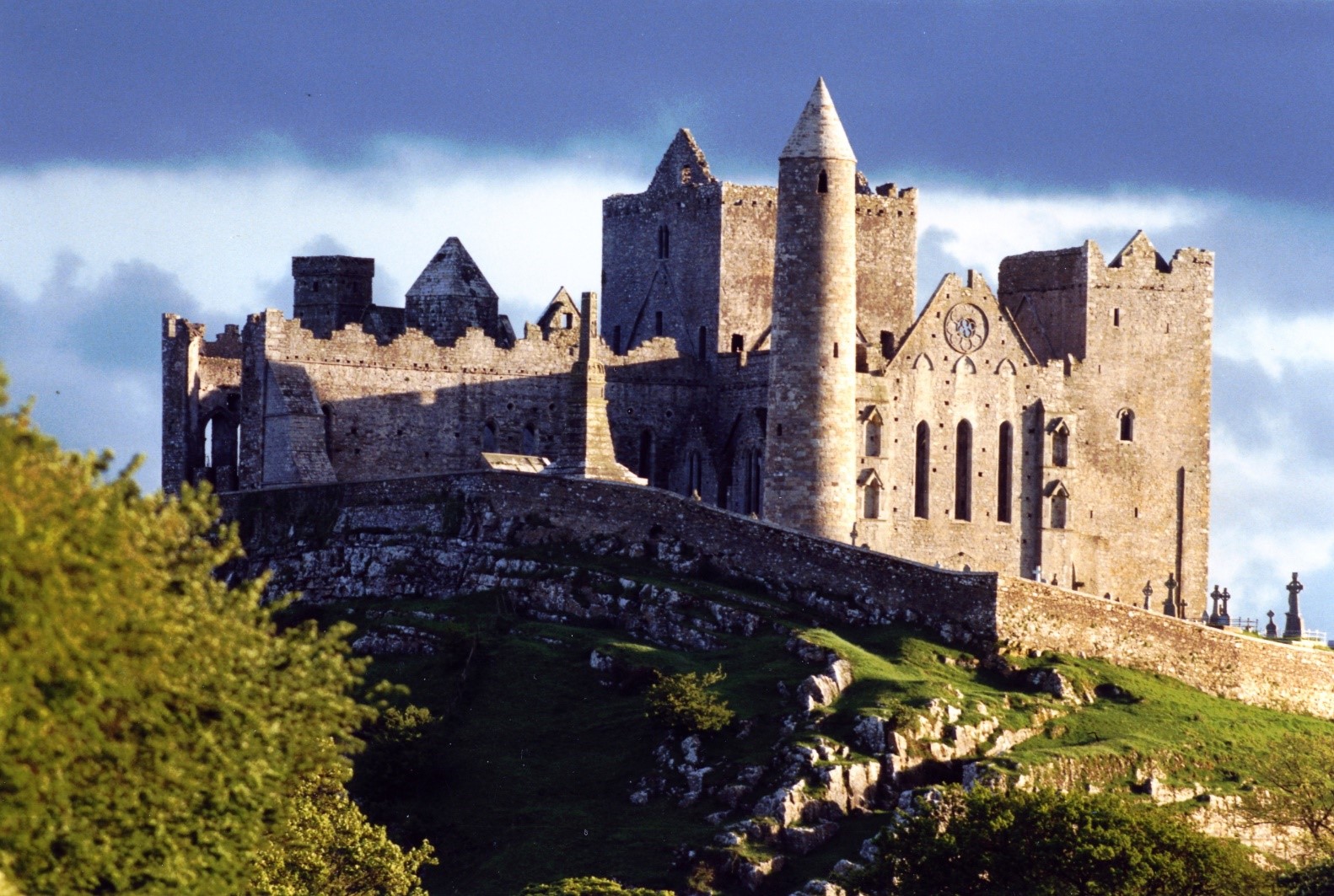 The Rock of Cashel is one of Ireland’s most visited sites, and is a spectacular and archaeological site. A collection of medieval ecclesiastical buildings set on an outcrop of limestone in the Golden Vale. The 12th-century round tower is of the oldest surviving building on the Rock, also include a high cross, and the ruins Romanesque chapel – Cormac’s Chapel is one of the earliest,and finest churches built in the Romanesque style. The 13th-century Gothic cathedral is a large cruciform Gothic church without aisles built between 1230 and 1270. Also a 15th-century castle and the Hall of the Vicars is the entry point to the ecclesiastical enclosure. The Hall houses the museum where the original Cross of St. Patrick can be found.The site includes an audio-visual show and exhibitions. The Rock of Cashel, also known as St Patrick’s Rock, is located just 500 metres from the centre of Cashel Town, County Tipperary.
The Rock of Cashel is one of Ireland’s most visited sites, and is a spectacular and archaeological site. A collection of medieval ecclesiastical buildings set on an outcrop of limestone in the Golden Vale. The 12th-century round tower is of the oldest surviving building on the Rock, also include a high cross, and the ruins Romanesque chapel – Cormac’s Chapel is one of the earliest,and finest churches built in the Romanesque style. The 13th-century Gothic cathedral is a large cruciform Gothic church without aisles built between 1230 and 1270. Also a 15th-century castle and the Hall of the Vicars is the entry point to the ecclesiastical enclosure. The Hall houses the museum where the original Cross of St. Patrick can be found.The site includes an audio-visual show and exhibitions. The Rock of Cashel, also known as St Patrick’s Rock, is located just 500 metres from the centre of Cashel Town, County Tipperary.
The Rock of Cashel is an ancient royal site of the kings of Munster and first attained importance as a fortress. Its origins as a centre of power go back to the 4th or 5th centuries. Two of the most famous people of Irish legend and history are associated with the Rock of Cashel. They are St. Patrick whom according to legend, arrived in Cashel in AD 432 and baptized King Aengus who became Ireland’s first Christian ruler. The second was Brian Boru, he was crowned High King here in 990. He is the only king who was able to unite all of Ireland under one ruler for any significant period of time.
- Titanic Belfast
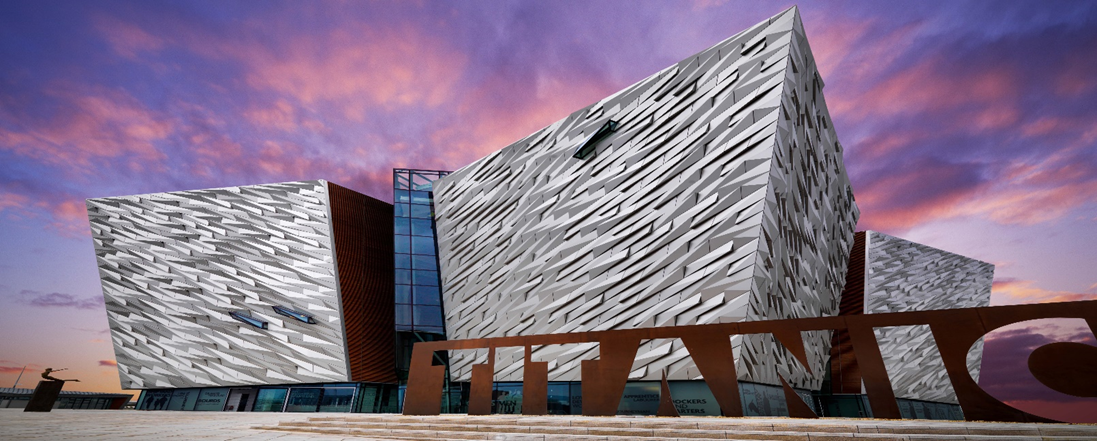 Since opening its doors in 2012 to mark the 100th anniversary of the Titanic’s fateful maiden voyage, Titanic Belfast has rocketed to the top of Northern Ireland’s tourist attractions, drawing over a million visitors in its first year. It seems fitting that the city should host the world’s largest Titanic visitor experience; after all, this was the city where the world’s most luxurious ship was built and first launched.Today, the area of Belfast Harbour that once housed the RMS Titanic has been renamed the Titanic Quarter and is dominated by the towering silver façade of the Titanic Belfast, a remarkable building fashioned from four ship-hull-shaped wings. The futuristic building is home to the state-of-the-art Titanic Belfast exhibition, which spreads over 6 floors and includes interactive discovery zones, full-scale reconstructions, real-life accounts and mind-blowing special effects.
Since opening its doors in 2012 to mark the 100th anniversary of the Titanic’s fateful maiden voyage, Titanic Belfast has rocketed to the top of Northern Ireland’s tourist attractions, drawing over a million visitors in its first year. It seems fitting that the city should host the world’s largest Titanic visitor experience; after all, this was the city where the world’s most luxurious ship was built and first launched.Today, the area of Belfast Harbour that once housed the RMS Titanic has been renamed the Titanic Quarter and is dominated by the towering silver façade of the Titanic Belfast, a remarkable building fashioned from four ship-hull-shaped wings. The futuristic building is home to the state-of-the-art Titanic Belfast exhibition, which spreads over 6 floors and includes interactive discovery zones, full-scale reconstructions, real-life accounts and mind-blowing special effects.
The RMS Titanic was built in Harland and Wolff shipyard, Belfast, between 1909 and 1912 and the estimated cost to build was $7,500,000.00. The RMS Titanic left Southampton, UK and set sail to New York, USA on 10th April 1912. It’s last stop was in Cobh (then called Queenstown), County Cork. The ship passenger’s manifest on 10th April 1912 was 2,223 and could accommodate a maximum 3,547 passengers. Although complying with the regulations of the time, the ship carried lifeboats for only 1,178 passengers.
The ships length was 269.10 meters and to operate its three engines at an average of 21 knots would have easily taken 825 tons of coal per day.
When the Titanic embarked on her maiden voyage the world was filled with hope. In just a few short days those emotions turned to horror and grief as it hit an iceberg 4 days into the voyage, at 11:40pm on 14th April 1912. The ship sank after 160 minutes upon hitting the iceberg.
Housed in an iconic, 6-floor building, this state-of-the-art visitor experience tells the story of the Titanic. The visitor begins in turn of the century Belfast, to learn why this city which was once the third largest in the Empire, was so industrialised. From there, the story of Titanic’s conception is told followed by its early construction, launch, fit out and tragic maiden voyage. The story is brought up to the present with the discovery of the wreck and into the future with live links to contemporary undersea exploration. Across ten galleries, with an equal number of interactive exhibits, Titanic Belfast will convey the sights, sounds, smells and stories of the shipyard and its most famous creation. Titanic Belfast extends over nine galleries, with multiple dimensions to the exhibition, drawing together special effects, dark rides, full-scale reconstructions and innovative interactive features to explore the Titanic story in a fresh and insightful way. Explore the shipyard, travel to the depths of the ocean and uncover the true legend of Titanic, in the city where it all began.
A visit to Titanic Belfast is a must during your time in the magnificent city of Belfast.
- Wild Atlantic Way
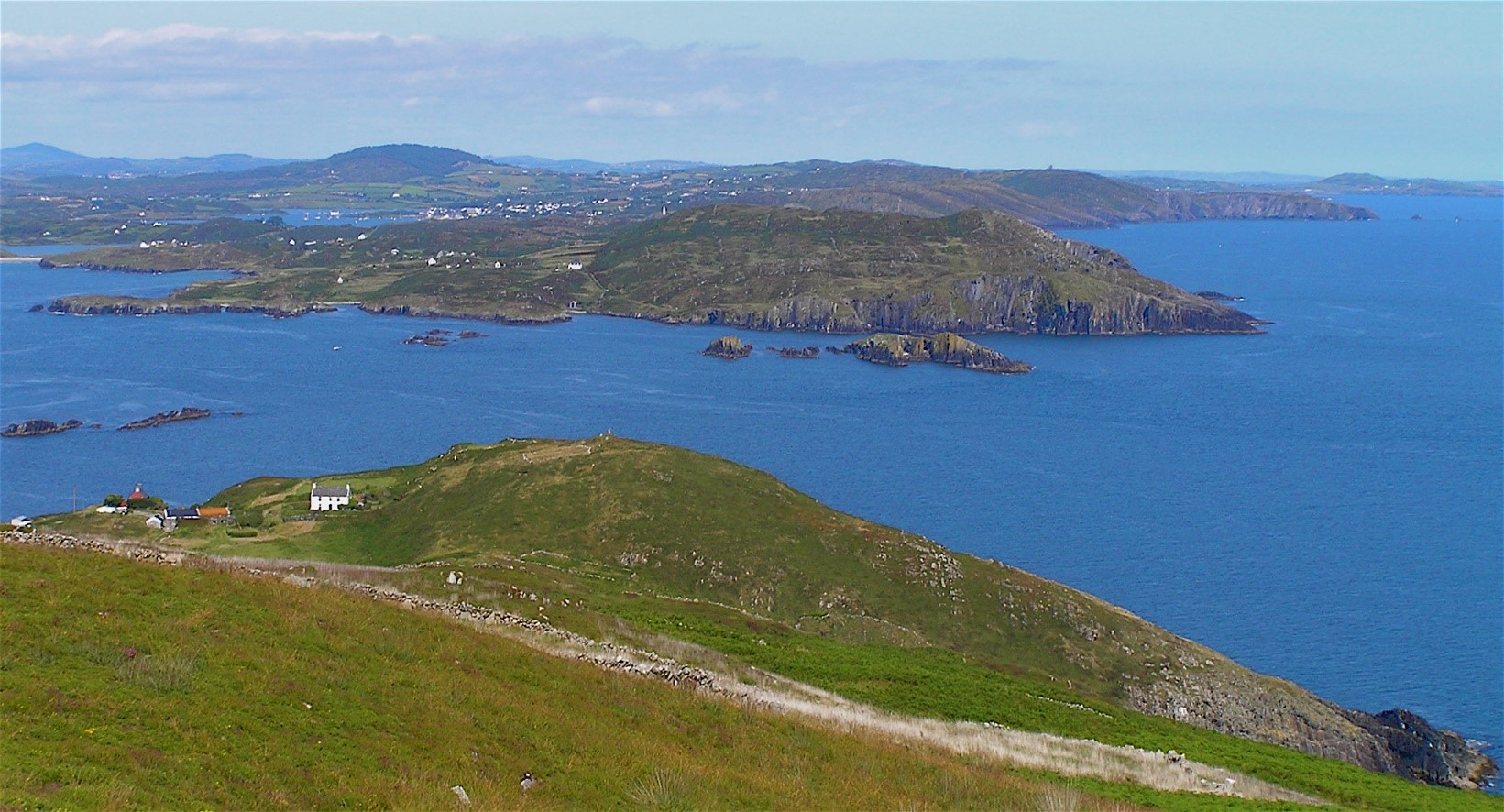 The Wild Atlantic Way is a world-famous coastal route that spans seven of Ireland’s counties, taking in some breathtaking scenery along the way. From Donegal to Galway, Kerry to Cork, the Wild Atlantic Way is a journey of discovery.From Malin Head to Fanad Head and Inishowen to Slieve League, Donegal’s section of the Wild Atlantic Way route is full of stunning surprises. Over millions of years the Atlantic has carved dramatic crevices into the rugged headland that are stunning to behold. The dramatic Slieve League cliffs are said to be some of the best and highest examples of marine cliffs in the world.
The Wild Atlantic Way is a world-famous coastal route that spans seven of Ireland’s counties, taking in some breathtaking scenery along the way. From Donegal to Galway, Kerry to Cork, the Wild Atlantic Way is a journey of discovery.From Malin Head to Fanad Head and Inishowen to Slieve League, Donegal’s section of the Wild Atlantic Way route is full of stunning surprises. Over millions of years the Atlantic has carved dramatic crevices into the rugged headland that are stunning to behold. The dramatic Slieve League cliffs are said to be some of the best and highest examples of marine cliffs in the world.
On the second stage of the Wild Atlantic Way, take in the majesty of Mullaghmore Head, Downpatrick Head and Keem Strand as you travel from Donegal to Mayo. Mullaghmore Head, off the coast of Sligo, is a paradise for surfers with a reputation for gigantic ‘prowler’ waves. Surfing schools abound in this neck of the woods, so if you want to get in on the action, take a lesson or two. Then it’s onwards to Downpatrick Head in Mayo, a spectacular headland rising 38 metres from the sea. Prepare to be charmed and beguiled by the sights and sounds of the Donegal to Mayo section of the Wild Atlantic Way.
As you continue through the Wild Atlantic Way, the Mayo to Clare section of the route will offer up its own unique landscape for your pleasure. The picturesque fjord of Killary Harbour nestles in the heart of Connemara, providing the perfect holiday hideaway. Sample some delicious and world-renowned local mussels before moving on with your journey. The patchwork of tiny lakes in the Derrigimlagh Bog are ideally explored by bike, while the magnificent Cliffs of Moher in nearby Clare need no introduction. Take your time travelling this section – the wealth of scenic attractions is worth savouring.
Before you say goodbye to Clare, visit the Loop Head peninsula, a region renowned for its breathtaking beauty. A visit to Loop Head Lighthouse offers panoramic views of Kerry and the Cliffs of Moher and is well worth the climb. Onwards to Kerry, where the Blasket Islands – just a boat ride from the Dingle Peninsula – await, rich in Irish heritage. UNESCO World Heritage Site Skellig Michael is next on your journey, an attraction steeped in tranquillity and mystique. Let the road take you on an exciting journey through the Clare and Kerry section of the Wild Atlantic Way.
The dramatic Kerry to Cork section of the Wild Atlantic Way provides the perfect backdrop to the end of your Atlantic odyssey. The rugged, remote Beara Peninsula of Co Cork is a stunning sight, with views of mussel rafts and seal colonies of Kenmare offering the perfect excuse for a pit stop. From Dursey Island to Mizen Head – Ireland’s most southern point – and then on to the Old Head of Kinsale, this stretch of the road should be enjoyed at leisure.
This is only a taste of what Ireland has to offer. There really is so much to see and do in the Emerald Isle. All Fairways and FunDays promise the very best of Ireland by day and by night – spectacular scenery, exhilarating entertainment, fantastic food, amazing activities, and magical memories are guaranteed!
Visit www.fairwaysandfundays.com today
Fairways and FunDays – Your Ultimate Golf & Ireland Experience

